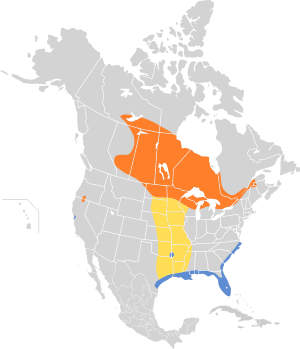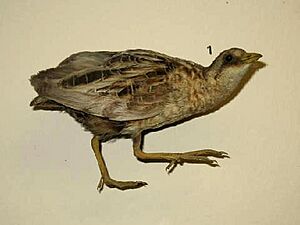Yellow rail facts for kids
Quick facts for kids Yellow rail |
|
|---|---|
 |
|
| Conservation status | |
| Scientific classification | |
| Genus: |
Coturnicops
|
| Species: |
noveboracensis
|
 |
|
The yellow rail (Coturnicops noveboracensis) is a small, shy bird that lives in marshy areas. It belongs to the Rallidae family, which includes rails, crakes, and coots. These birds are often hard to spot because they hide well in tall plants.
Contents
What the Yellow Rail Looks Like
Adult yellow rails have brown feathers on their backs with black stripes. Their chests are yellowish-brown, and their bellies are light. They have striped patterns on their sides.
Their short, thick beaks are dark. During the time they lay eggs, the male's beak turns yellow. The feathers on their backs have white edges. They also have a yellow-brown stripe above their eyes. Their legs are a greenish-yellow color.
Size and Weight:
- Length: About 5 to 7 inches (13 to 18 cm)
- Weight: About 1.4 to 2.4 ounces (41 to 68 grams)
- Wingspan: About 11 to 12.6 inches (28 to 32 cm)
Where Yellow Rails Live
Yellow rails live in wet meadows, bogs, and shallow marshes. They breed in Canada, east of the Rocky Mountains. They also live in the northeastern United States and along the northern Canada–US border. This area includes the Great Plains and the Great Lakes region. A small group might also live in northern Mexico.
These birds do not stay in one place all year. They migrate to the southeastern coastal United States for the winter.
How Yellow Rails Behave
Yellow rails are very secretive birds. They are rarely seen because they are so good at hiding. They usually make sounds at night. Their call sounds like two stones clicking together, making a "tik-tik tik-tik-tik" noise over and over.
When something comes close, they usually stay hidden. They rely on their camouflage to blend in with their surroundings. They prefer to run away on foot through thick plants rather than flying.
Reproduction
The yellow rail builds its nest on damp ground. The nest is a shallow cup made from marsh plants. It is hidden under a cover of dead plants. They weave grasses and leaves together to make it.
A female yellow rail usually lays 5 to 10 eggs. The eggs are oval-shaped and measure about 1.1 by 0.8 inches (29 by 21 mm). They are creamy in color. The eggs have reddish spots that form a ring at one end. They also have small black spots scattered all over.
The female bird sits on the eggs to keep them warm. This is called incubation. It takes about 16 to 18 days for the eggs to hatch. If the first set of eggs is ruined, the female will often lay more eggs. After the chicks hatch, the female either crushes the empty eggshells and hides them. Or, she carries the shells away from the nest and drops them along her paths.
What Yellow Rails Eat
Yellow rails mostly eat small invertebrates. These are creatures without backbones, like insects. They also eat plant seeds.
Their favorite food is beetles. Spiders and snails are also a big part of their diet. For plants, they mainly eat seeds from sedges and rushes.
Status of Yellow Rails
The number of yellow rails has gone down in recent years. This is mainly because they are losing their natural homes. Many of the wet meadows and marshes where they live are disappearing.
See also
 In Spanish: Polluela amarillenta para niños
In Spanish: Polluela amarillenta para niños



